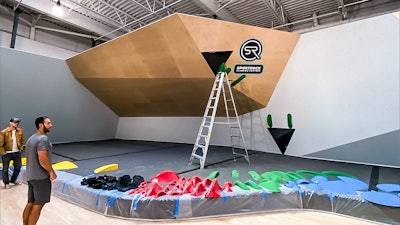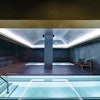
 Photos courtesy of EP Climbing
Photos courtesy of EP Climbing
Mallory’s response was that of a recreational climber of the purist sort — one who sought out the tallest natural object amid the landscape and proceeded to scale it. Climbing has evolved since then (as have the facilities used by enthusiasts) to such an extent that Mallory likely wouldn’t recognize some variants of the modern sport of climbing. For instance, some climbers never venture outdoors, instead working toward overcoming set routes on indoor walls that do not at all resemble the rocky face of Everest.
Adam Koberna, president of Walltopia, which makes and installs climbing walls, acknowledges the dramatic changes in climbing. “Back in the day, indoor climbing was for training only,” says Koberna, himself a recreational climber. “You did not admit that you did it. It’s not something you talked about. You just did it for training for outdoors. You went in, and you trained and you left. Today, I would say 70 percent of the people who identify as climbers will never ever go outside. They’ll say, ‘I’m an indoor climber.’ ”
The shift to indoor-centric climbing has been led by private and public climbing gyms, and now colleges and universities, many with decades-old fiberglass walls that look like the side of El Capitan, have taken notice. Schools once content to put a tower in their rec center lobby — as much a centerpiece as a serious fitness apparatus — are now mulling plans to renovate their climbing facilities in an effort to keep up with the sport, while also meeting the needs of a new generation of enthusiasts.
 Photo courtesy of EP Climbing
Photo courtesy of EP Climbing
Bryce Benge, president of EP Climbing, which also makes and installs climbing walls, says private climbing gyms, seeking to generate revenue, attracted a new demographic to the sport that spurred dramatic changes in facility design. “The commercial facilities started evolving to include more amenities — yoga, Pilates, weight rooms and exercise machines, and all kinds of other things, and the walls evolved along with that to be more and more usable by different groups,” says Benge. “A real-looking rock wall typically is limited on the different types of handholds that you can put on it, so the featuring on the wall is very set, it looks like a rock and that rock doesn’t change at all.”
Tear down that wall
When Koberna started in the industry back in the early 2000s, he says fiberglass walls, molded to replicate real rock surfaces, were the only thing going. Colleges and universities were at the forefront of adopting this trend, building towering structures that were visually impressive but not very flexible in terms of programming.
“The rule was no plywood,” says Koberna. “‘We will not build plywood. We will build fiberglass because it meets fire codes, because it lasts, because it does this, because it does that.’ The problem was that these walls were too highly featured, and you couldn’t do route-setting. But nobody cared about that back then.”
Now Koberna says those walls are still standing on college campuses, but they may not be for long. “A lot of these schools are struggling in a way, and they were the ones that helped promote the sport, and the reason the climbing industry does so well is partly because they were the first mainstream institutions to embrace climbing,” he says. “And now many of those facilities need an update. We’re getting a lot of renovation questions, and I don’t think we’re there yet, but I do think people are starting to think about it. It’s definitely going to start moving through [college and university] systems, and within two years, I think this is going to be a thing.”
When they do update their facilities, schools will most likely be tearing down their existing fiberglass walls in favor of plywood structures that allow routes to be changed and holds to be modified daily if desired.
 Photo courtesy of Walltopia
Photo courtesy of Walltopia
 Photo courtesy of EP Climbing
Photo courtesy of EP Climbing
Benge explains that the ability to set and change routes has become core to revenue generation for private climbing gyms. “Along with the growth and popularity of competition climbing, there was a demand for walls that allowed more variation in the route-setting. The product has become, over time, at least on the commercial side, the route-setting itself. We have an infinite number of holds, we can have an infinite number of routes, and that’s what keeps the customers coming back over and over again. They’re saying, ‘I’m not getting bored, I haven’t done this 1,000 times. It changes every two weeks,’ or whatever the strategy may be. So that allows that revenue stream, at least from the business side, to continue on.”
While many universities and their students still love their fiberglass structures, a younger generation of students who may have come to college already hooked on indoor climbing at public gyms are pushing for more modern facilities on campus.
“The student base is saying, ‘Hey, this isn’t meeting our need for climbing here,’ ” Benge says. “Or they’re competing against the university across town that has a new facility that has this new wood wall that allows all the newest types of holds, really state-of-the-art route-setting and things like that. The university that has the real rock wall can’t do that. Now they’re kind of at a competitive disadvantage.”
 Photo courtesy of Walltopia
Photo courtesy of Walltopia
Fits like the pieces of a puzzle
College decision-makers might ask, “What does one of these new plywood walls look like and what are the advantages of proceeding with a renovation?” Benge suggests that any climbing gym renovation should improve the user experience, attract new climbers and increase revenue. A well-maintained and updated climbing wall can also help any institution stand out from the competition and provide a safe and enjoyable environment for end-users.
 Photo courtesy of EP Climbing
Photo courtesy of EP Climbing
Benge explains the walls are modular, allowing for unique layouts and easier maintenance.
“It’s a modular panelized system. It’s a fully industrialized production process, where it’s made on computer cutting machines,” he says. “We even have computerized painting machines, and different things like that, so you essentially have like a 3D mosaic of these panels.”
The panels, which can run from as large as 5 square feet to as small as 2 by 3 feet, fit together like a puzzle. “It may be a ton of little 2-by-3-foot weird little triangles and trapezoids, and things like that,” Benge says. “They all get put together in a 3D puzzle, and connected structurally behind the wall. It’s one piece in the end, so it’s structurally true and sound, and it makes the maintenance in the future easier.”
Schools have a number of different ways they can proceed with a renovation, from tearing down an existing structure to the ground, to a partial teardown, which might be less expensive but slightly more challenging on the design side. Benge references a new wood wall EP installed at the University of Texas at San Antonio, which amounted to a “reskinning” of the facility’s old fiberglass wall. “That saves the client a little bit of costs on the reuse of materials and things like that,” says Benge. “But it becomes more of an engineering challenge. And how do you change a system that was made for this into a system that’s made for something different? There’s a bit more technical work on that versus tearing it down to the floor, essentially, and starting new and saying, ‘Okay, we’re just going to bring a whole new system in, and it’s just going to work.’”
 Photo courtesy of Walltopia
Photo courtesy of Walltopia
Optimizing space, creating community
Beyond just accommodating a new type of climbing, any renovation of an existing structure should seek to make efficient use of available space. Given that plywood bouldering walls generally have a lower profile than monstrous fiberglass structures, universities have more design options when considering a renovation, allowing them to build spaces that are as conducive to community gathering as they are to climbing.
“Building a community is one of the keys,” Benge says. “These facilities need to have a community of core climbers, and that comes down, at least partially, to the amenities. A climbing facility should offer spaces to hang out where I could potentially open up my computer and do a little bit of work in the middle of my climbing session. There are definitely facilities that offer drinks and beer and different things like that. So that type of community-building is one of the keys to building a commercial facility, and really any facility — the universities and the rec centers. We do see a trend of those climbing spaces growing in that direction.”
 Photo courtesy of Walltopia
Photo courtesy of Walltopia
Koberna agrees, stressing the necessity of communal spaces. “Whether that space is for a competition and spectators, or whether it’s for just hanging out and sitting down, if you want people to use the facility, you need to design for that social space.”
Benge references the University of Michigan and Montana State, both institutions that have made the leap to large-scale, modern climbing facilities that include complementary programming and amenities that promote community. “In the rec center at Montana State, there are other amenities already that they’re piggybacking on — they have the yoga, they have the hangout spaces and all that kind of stuff,” he says.
An upgrade to a modern plywood wall is also more suited to support club and intramural climbing teams, as well as competitions, which only further a sense of community around the sport. “Almost all universities, and some city-based rec centers, have their own internal competitions,” says Benge. “They say, ‘Hey, we have our members, here are all the students who are hanging out. We’ve got on average 1,000 check-ins every week. Let’s have the University of Michigan Boulder bash,’ or whatever. And it’s just like a little internal competition that anyone can have fun doing, and it just creates that community-building. It’s creating the interest.”
From the summit of Mt. Everest, Mallory could see far and wide, but not the future. Now an Olympic sport, climbing continues to evolve to accommodate how modern-day enthusiasts choose to engage with the sport. As colleges and universities usher in the next generation of climbers, they’ll need to build versatile walls that can change with the prevailing trends of the sport itself, while also creating spaces to accommodate an ever-growing climbing community.

































